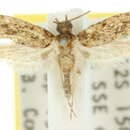Comprehensive Description
provided by Smithsonian Contributions to Zoology
Setomorpha rutella Zeller
Setomorpha rutella Zeller, 1852 [1854]:94.—Walsingham, 1891:81.—Miller, 1932:10, 22, 50.—Leefmans, 1934 [1933–1934]:89.—Diakonoff, 1938:399–414, figs. 1–10.—Ghesquière, 1940:11, pl. 3: fig. 4; 1941:763.—Corbet and Tams, 1943c:111, 119, figs. 200, 235, 262, pl. 5: figs. 9, 10.—Paulian and Viette, 1955:146.—Hinton, 1956:261.—Viette, 1956:533.—Gozmány, 1966:257; 1967:29, fig. 30.—Diakanoff, 1968:284, 308, fig. 773.—Clarke, 1971:188, fig. 145, pl. 25e.—Dugdale, 1977:66.—Zimmerman, 1978:378, figs, 201, 202, 203, 204.
HOLOTYPE.—In the Naturhistoriska Riksmuseum, Stockholm.
TYPE-LOCALITY.—Africa.
DISTRIBUTION.—General in the tropical and subtropical regions.
Hiva Oa: Atuona, 11 Feb 1968. 1.
FOODS.—Many stored animal and vegetable materials.
Although the genitalia of this species have been figured several times previously, I am repeating the illustrations used in Clarke (1971, fig. 145). For a more extensive bibliography than that shown above, see Diakonoff (1938:405–409) and Davis (in Hodges et al., 1983).
Clepticodes Meyrick, 1927b:332.
TYPE-SPECIES.—Clepticodes horocentra Meyrick, 1927b:332; by monotypy.
- bibliographic citation
- Clarke, J. F. Gates. 1986. "Pyralidae and Microlepidoptera of the Marquesas Archipelago." Smithsonian Contributions to Zoology. 1-485. https://doi.org/10.5479/si.00810282.416

